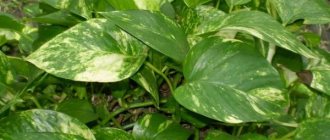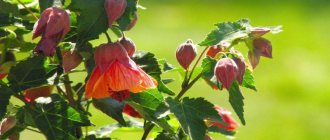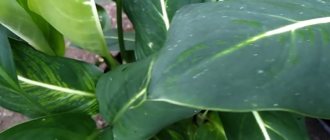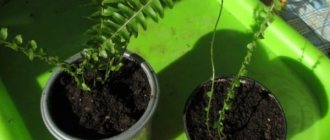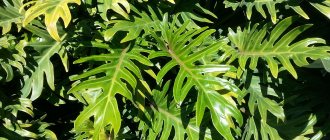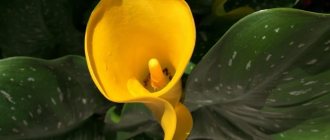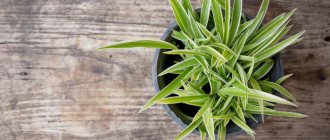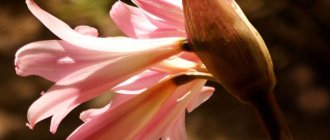Author: Elena N. https://floristics.info/ru/index.php?option=com_contact&view=contact&id=19 Category: Houseplants Published: February 25, 2019Last edits: January 11, 2021
- Philodendron melanochrysum andreanum
If you like large vines, then you will be interested in reading our article about philodendron, from which you will learn:
- what types and varieties of plants can be grown indoors;
- where is the best place to place a philodendron and how to care for it;
- how to replant and propagate this vine.
And if you have never heard of this plant, then you should know that its large carved leaves can predict rain with greater accuracy than the weather center. In addition, philodendron purifies the air from benzene and formaldehyde, which are contained in modern building materials.
Shy but persistent Philodendron blushing vine
Everyone knows that philodendrons are one of the most undemanding indoor plants in terms of lighting. However, among them there are varieties that seem to be specially bred for dark rooms. These include Philodendron blushing - a wonderful, well-developed liana. Even in the northern room she will feel good. Moreover, such lighting will not affect the appearance of the flower in any way - its color will remain just as bright. What else is different about this philodendron and what it loves, let’s find out now.
Philodendron: types
There are more than 200 different types of plants. However, the most popular ones are presented below:
- Philodendron Ivy-shaped, Warty, Variegated, Bipinnate, Lyre-shaped, Radiant, Heart-shaped, Scale-bearing;
- Philodendron Sello;
- Philodendron Xanadu;
- Philodendron Guitar;
- Philodendron Jellyfish;
- Philodendron Atom;
- Philodendron Imperial Red;
- Philodendron Lobed;
- Philodendron Burle Marx;
- Philodendron Philodendron;
- Philodendron Cobra;
- Philodendron Brazil;
- Philodendron Goldie Lock;
- Philodendron climbing;
- Philodendron Blushing;
- Philodendron Scandens;
- philodendron: Mediopict Tricolor, Pink (pink) Princess, Magic mask (Magic mask), Silver queen, Scanden, Mikans, Green, hybrid Birkin,
- Jungle and Mosstka.
Thus, ease of care and many species make it possible for both professionals and amateurs to grow this plant in greenhouses and at home. But don't neglect safety measures. The plant is poisonous; all procedures are best carried out with rubber gloves. The slightest contact of juice on an open area of skin provokes a severe allergic reaction.
Philodendron blushing - why is it called that?
The vine owes its name to its color. Young leaves, stems and petioles of philodendron first have a beautiful red color. As the foliage develops and matures, it turns green, but the petioles themselves remain red.
This vine is considered to be non-branching. Most often, philodendron grows into one long shoot that bends bizarrely. However, sometimes lateral processes may appear on it.
The leaf plate of the plant is solid, linear in shape. At the petiole itself, the leaf looks like a heart, but then it stretches out, and the tip becomes elongated and pointed. The total length of the sheet is about 20 cm with a width of 15 cm.
Philodendron blushing is a separate type of crop with its own subspecies. The most popular varieties of blushing vine are:
- Burgundy. It grows slowly and needs bright, indirect light.
- Emerald. It has larger leaves up to 25 cm long.
- Jellyfish. The variety is characterized by yellow leaves, while the petioles and stems are red. Grows quickly.
Philodendron
Philodendron is an evergreen flowering perennial plant from the Araceae family.
Specialists at the Missouri Botanical Garden count approximately 900 species of this plant. All of its representatives have not been fully studied. Philodendrons are common in the tropical zone of America, Australia, and the Pacific Islands. They prefer damp, warm forests, swamps, and river banks. The name Philodendron is literally translated from Greek as “ I love the tree .” In its natural habitat, this plant cannot grow without the support of its own tree. Several types of philodendrons are grown indoors. Considering the huge size of an adult plant, only owners of large, spacious premises can afford to grow this plant. Philodendron has some similarities with Monstera.
Among philodendrons there are epiphytes, hemiepiphytes and hemiepiphytes. But there are more epiphytes that use aerial roots to attach to a support. If there is no tree next to the plant, it will crawl along the ground behind the shadow of a tree or fence. Philodendron can have both underground and aerial roots. It uses numerous small, hairy aerial roots for support. With thick and long roots it obtains food for itself and absorbs moisture.
The tropical plant has fleshy stems that are woody at the base. The size of the alternate, petiolate leaves in some cases reaches two meters in length. Leaf blades can be oval, pinnately dissected, arrow-shaped. In some cases, the leaves of the same plant may have different sizes and shapes. As a rule, philodendron leaves are colored in different colors, but the upper ones have a darker shade. The inflorescence is a spadix with a waxy two-color blanket that looks like a hood. The fruit is a small berry.
Most plants that belong to the Araceae family are grown in greenhouses and winter gardens. They will decorate large halls and lobbies. For a standard city apartment, the climbing Philodendron is most suitable. This species does not require a large space for normal growth and development. It is grown in a hanging pot or basket like a regular hanging plant. In addition, it is shade-tolerant and unpretentious.
Compact species include Philodendron warty. It has beautiful decorative leaves. But he cannot grow without support. Philodendron Sello is considered no less attractive. Its height reaches 1.5 meters, and it can grow even wider in width, since it has large leaves 80 cm long. The guitar-shaped Philodendron is very beautiful, the leaves of which resemble a famous musical instrument.
What care does the vine need?
The blushing philodendron is a big lover of moisture, as are other types of this vine. It needs to be watered regularly, and the leaves should be periodically sprayed with a spray bottle. You can also wipe them with a damp sponge. The flower loves constancy and will respond to temperature changes by shedding its leaves. The room should be warm; in winter, 12 degrees is enough. But a draft for philodendron is a real killer. Opening windows or the street are not at all intended for vines. It is better to place the flowerpot on a shelf on the wall or place it on an east window.
If you overdo it with watering and spraying, the vine will immediately react to this: drops will appear on the leaves.
To maintain intense color from spring to autumn, the plant must be “fed” with mineral complexes. It is enough to do this twice a month with the same break. In winter, philodendron does not need additional nutrition.
In conclusion, I would like to remind you once again that this rather large vine needs support. Otherwise, the stem will twist itself out in search of something to cling to. Plus, it might break.
Video review of Philodendron blushing
Plant characteristics
Philodendron is an ornamental plant that belongs to the Araceae family. In nature, this plant can be found in the tropical rainforests of South or Central America.
Philodendron is a creeping vine whose stems are long, fleshy, and semi-herbaceous.
The plant may have only one short, thick stem. Some Philodendron species have very shortened internodes. These are the so-called rosette plants.
Philodendron's roots are aerial and form from each node. Thanks to these roots, the plant can wrap itself around the tree and climb upward if there is not enough light. When grown indoors, aerial roots should not be removed.
This ornamental plant's leaves can be of different colors, shapes, and sizes. They can be entire or deeply dissected, small, medium or large. The leaves are arranged alternately. The plant can reach up to 2.5 m in length.
The inflorescence has a spadix and a spathe. The plant can produce up to 11 inflorescences.
There are many types and varieties of plants:
Philodendron climbing
It has a twisting stem and abundant aerial roots. It bears matte green leaves, which can reach 14 cm in length. Usually the leaves are heart-shaped, pointed at the end.
Philodendron warty
It is a vine with purple petioles covered with hairs. The leaves are heart-shaped, green-bronze, and can reach 17 cm in length.
Philodendron Climbing (photo)
Philodendron blushing
The leaf blade is elongated, pointed at the end, and can reach a length of 40 cm. The outer side of the leaf is green and glossy, and the inner side has a reddish tint.
Philodendron graceful
Has a thick stem. The leaves are pinnately dissected, oblong or ovate. Their width varies between 30-50 cm, and length - 40-80 cm. This species grows quite slowly; for good development, Philodendron graceful should be placed in a bright room.
Philodendron black and gold
Resembles the climbing Philodendron. The leaves of this species are green with a black tint. At home it can grow to the ceiling.
Kinds
Since there are too many philodendrons both in nature and in culture, we will try to introduce you to the most famous and popular species and forms. So…
Philodendron melanochrysum andreanum
A highly decorative appearance due to its heterophylly (varieties of leaves): young leaves are small (5-7 cm long) - heart-shaped, copper-red, and adults reach from 40 to 80 cm in length (in nature, of course), more oblong in shape , color – bronze-green with whitish veins and a narrow light border along the edge. At home it is demanding regarding air humidity.
- Euonymus (Euonymus) – care, photos, types
Philodendron micans
This is a small and compact vine. The stems are thin, the leaves are up to 10 cm long and up to 5 cm wide, velvety, young ones are reddish in color, adults are brownish-green. Unpretentious.
In the photo: brilliant Philodendron (Philodendron micans)
Philodendron verrucosum
It is very popular among flower growers because it is incredibly beautiful: heart-shaped velvety leaves 15-20 cm long and 10 cm wide grow on petioles densely dotted with warty bristles. The problem with this species is that it does not tolerate dry air well.
In the photo: Philodendron verrucosum
Philodendron bippenifolium
Also in demand in culture. Its leaves, shaped like a famous musical instrument, reach 40-50 cm in length. The plant is not capricious and has already served as the basis for the breeding of several highly decorative hybrids.
Philodendron bipinnatifidum
And Philodendron selloum . Despite the external similarity, which misleads many, these are two different species. They are large vines with a woody, powerful trunk. The bipinnate philodendron is very rare, but the Sello philodendron is widespread in cultivation.
In the photo: Philodendron Sello (Philodendron bipinnatifidum)
Philodendron erubescens
The most famous species among flower growers, which served as the basis for breeders who successfully developed many varieties with its participation. The trunk of the vine is red-green, with age, when it becomes lignified, it turns into gray-golden. The leaf petioles at the base are dark red, the leaves are 25-30 cm long, 15-20 cm wide. The spathe covering the fragrant cob is white - 15 cm long, dark purple. The plant is completely unpretentious and tolerates infrequent watering, poor lighting, and insufficient air humidity.
In the photo: Philodendron erubescens
In addition to the above, such types of philodendrons as arrow-leaved philodendron, scale-bearing philodendron, drop-bearing philodendron, graceful philodendron, ivy-shaped philodendron, lobed philodendron and many others are also grown in culture...
Varieties of Philodendron blushing
Most often, Philodendron blushing is grown indoors. There are several varieties of this plant on sale:
Burgundy variety
Philodendron grows extremely slowly (photo)
It grows slowly. Leaf blades, petioles and shoots are dark red. This variety requires bright and diffused light. Unlike other varieties, Burgundy contains low amounts of chlorophyll. If there is insufficient air humidity, the flower suffers greatly.
Varieties and varieties
In specialized stores you can purchase blushing philodendron of several popular varieties:
- Burgundy - a flower (lat. P. erubescens Burgundy) is characterized by slow development, prefers bright but diffused light, leaves, petioles and young shoots have a wine-red color, which is why the amount of chlorophyll in them is reduced;
- Red Emerald - plant (lat. P. erubescens Red Emerald) has larger leaves compared to other species, colored red;
- Mandarin is an interspecific hybrid (lat. P. x mandaianum), similar in appearance to the varieties above, young leaves are colored red, but turn green with age;
- Jellyfish - a flower (P. erubescens Medusa) is demanding on lighting, grows quickly, has a characteristic yellowish color of the leaves, and the stems and petioles are colored in shades of red.
Philodendron propagation methods
When cutting, it is necessary to cut off the upper part of the shoot, on which there are 3 developed leaves. Treat the cut areas with heteroauxin, a special stimulator for root growth. Root the cut shoot in a mixture of peat and sand.
Cover the top with film and place in a room with high humidity at a temperature of 20-22 degrees. You can root not only shoots, but also stem cuttings. They should have a bud and one leaf.
In addition to cuttings, Philodendron can also be propagated by seeds. Pour sterilized soil into a small container and deepen the seeds 5 mm. With this growing method, the temperature should be 25-28 degrees.
The plant reproduces very well by seeds
Cover the top with film or glass to ensure high humidity. The first shoots will appear in 6-7 weeks. After the formation of 2-3 leaves, the seedlings are planted. Very young leaves have a simple shape, and over time they acquire the shape characteristic of Philodendron.
The method of propagation by small fragments of a trunk is carried out as follows: cut pieces of a lignified trunk with one or two nodes. Pour the peat-sand mixture into the container and place the prepared fragments there.
Fold it so that the kidney is on top. Then sprinkle with soil, moisten and cover with plastic wrap. To prevent the cuttings from rotting, the container should be ventilated 2-3 times a week. Once roots appear, they can be planted in pots.
If two Philodendrons bloom at the same time at home, you can cross them.
The soil for plant propagation should consist of peat, bark, coal and sphagnum. All components must be taken in equal quantities. You can add sand, perlite, leaf or grass humus to this mixture.
When pruning the plant, you should use special gloves, as it contains poisonous sap.
Precautions must be taken as the plant sap can cause skin irritation.
What does a philodendron look like?
It is a variety of vines that belong to the class of evergreens from the Araceae family. The birthplace of this plant is considered to be Mexico and the countries of South America. Translated from Latin, the name of the tropical plant means “favorite of trees.”
The fact is that there is not much light in a dense tropical forest, so the philodendron, entangling the trees, tends upward towards the sun.
Philodendron at home
The history of selection of this plant dates back to 1900. Until this time, philodendron was considered a wild poisonous species. However, experiments conducted by British researcher Simon Mayo led to the conclusion that the plant is safe and can be considered as an ornamental plant.
When and how to replant Philodendron
Philodendron must be replanted 3-4 years after planting. If the roots of the plant have completely filled the pot, then you can replant it earlier. It is better to transplant in spring or early summer.
The soil should be slightly acidic, loose and nutritious. The pot should be spacious, with a wide base to balance the heavy bush.
Turf soil is often used for replanting.
For replanting, you can use turf soil, coconut substrate, compost, vermiculite as a soil mixture in a ratio of 1:1:1:0.5. In a specialized store you can purchase a ready-made mixture intended for transplanting decorative deciduous plants.
Before transplanting the plant, be sure to lay a drainage layer on the bottom of the pot.
If salt deposits form, a large plant should not be replanted. The top substrate must be removed and the soil replaced.
In some species of Philodendron, after replanting, it is necessary to pinch out elongated branches. This procedure activates the emergence of new shoots.
It should be remembered that the transplanted plant does not need feeding.
Transfer
The root system of philodendrons is characterized by slow growth compared to the above-ground part. Young plants that were planted relatively recently do not need to be disturbed by replanting during the first year.
Reference. Initially, plant the plant in a pot “for growth”, with a margin of 2-3 cm more than the root system.
Adult plants need it once every 3-4 years. Their root system is able to weave itself into a tight knot during this time.
Transplantation is usually carried out in late March - early April. Do not touch the soil stuck to the roots, just carefully pull out the flower and place it in a pot 3-4 cm wider in diameter and 5-7 cm higher in height than the previous pot.
Attention. An overly large pot can cause stagnation of moisture in the soil and cause root rot.
It is necessary to place drainage material at the bottom - pebbles or expanded clay. After this, pour fresh soil into the container. The roots of the plant should be underground, and the root neck should be slightly above. After this, it is recommended to water the plant, and add a little more soil when the soil settles.
Plant care
The plant is unpretentious in care, but at the same time it requires compliance with certain rules.
Philodendron tolerates low temperatures very poorly. Temperature changes will lead to the death of the plant. For good growth in the room where the Philodendron is located, the temperature should be 16-25 degrees. In winter, the temperature should not fall below 12 degrees. Philodendron does not like drafts.
It is important to ensure that direct sunlight does not fall on the leaves. The light should be bright and diffused. Therefore, it is better to place an ornamental plant on eastern or western windows.
The plant should be watered with settled water at room temperature. In summer, watering should be plentiful.
Between waterings, you must ensure that the soil dries out, otherwise the plant may die. With the onset of autumn, watering should be reduced. In winter, watering should be done even less often. In summer, it is advisable to spray the leaves of the plant.
For good growth and development of the plant, high humidity is required. To ensure high humidity, the pot with Philodendron must be placed in a tray, first filled with wet expanded clay or pebbles.
It is advisable to fill the bottom with pebbles
It is recommended to wipe the plant leaves once a week with a damp sponge.
The ornamental plant is rarely exposed to diseases. They occur when care rules are not followed. Sun rays can cause leaf burn. As a result, the leaves will begin to turn yellow and fall off. This is also observed in dry indoor air.
As a fertilizer for Philodendron, you can use a mixture consisting of nitrogen, potassium and phosphorus in equal proportions. It is advisable to feed every 2 weeks. You can buy fertilizer for Philodendron at a flower shop. In winter, there is no need to fertilize the plant.
If Philodendron is located in a warm room, then fertilize it with a small amount of mineral mixture once a month. It is important not to overfeed the Philodendron. This may primarily affect the leaves.
Lack of nutrients due to infrequent feeding will affect plant growth and stem thickness.
I have a large garden and vegetable garden, several greenhouses. I love modern methods of cultivating plants and mulching the soil, and I share my experience.
Regarding lighting, it is worth considering that species with variegated foliage need more light than those with a single color. If you want to grow this flower, but the windows are not lit enough, give preference to the climbing Philodendron and the blushing Philodendron. They tolerate partial shade normally, and in appearance they are not inferior to other forms.
Although this flower loves to be watered, there should be no moisture left in the tray. If the leaves turn yellow, this means that there is too much moisture and it is worth changing the watering regime. If the foliage begins to fall off, this indicates that the soil in the pot is drying out, which also should not be allowed. It is important that the water for irrigation does not contain lime, otherwise stains will begin to appear on the leaves.
If the leaves become smaller, it means the air is too dry for the flower. You should especially carefully monitor the humidity in the room during the period when the heating is on. When the plant is still relatively young, you can give it a shower.
When you need a plant to be taller and grow faster, you should feed it with nitrogen-containing products. If you want to make it more decorative and compact, then you should refrain from such means. All variegated forms do not like nitrogen fertilizers. Although philodendron responds well to fertilizers, you should not overuse them, otherwise the leaves will begin to turn yellow.
Description of the plant
Philodendron erubescens is one of the largest and most common species of philodendron. This unique plant creates stunning stands in Brazil, Colombia and Costa Rica. It was discovered relatively late - in the middle of the 19th century.
Philodendron blushing is a real giant from the class of ascending evergreen vines. With a natural size of up to 15 m, to which the plant stretches in search of light, in a room it will not exceed 2.5 m.
Philodendron blushing grows very quickly and changes literally before our eyes, becoming both more powerful and brighter. Even with pruning and sharply limiting the length of the shoots, the bushes will not branch and create compact, lush forms. To create spreading, dense bushes, several vines are grown in one container, creating a more lush mass and a more massive effect.
The aerial roots of this plant are no less spectacular than those of most of its fellows. They develop from each node, often twining around the trunk itself and supports, giving the plant additional texture. Long, impressive, they emphasize the forest beauty of the blushing philodendron.
The leaves of Philodendron blushing are often compared to the beauty of rubber ficus and alocasia. And not by chance. Solid, very large, they seem simple and elegant at the same time. The heart-shaped, oval, slightly elongated shape with a heart-shaped base and pointed tip gives the entire plant neatness, and the wavy edges, luminous middle vein, and glossy-gray sheen of the surface smooth out excessive severity.
Philodendron leaves can reach 40 cm in length and up to 30 cm in width; they look like giant hearts on long colored petioles. The lower matte side and the glossy upper side traditionally contrast.
The color palette of the plant is quite predictable even from its name. Philodendron blushing is characterized by rare shades of dark green base color - emerald and marsh.
But it received its specific name for the uneven red tint of its petioles and stems. The young leaves of the plant also prepared more than one surprise. After all, the unique muted scarlet-brown shade seems to spread onto the leaves, shine through, and bashfully hide until it changes to pure green. A light touch of color gives this philodendron a more noble appearance.
If the blushing philodendron is comfortable in the house, it can surprise with a bright, unusual inflorescence. © Andre Benedito
Blooming Philodendron blushing
In indoor conditions, especially if ideal temperature conditions are not created during the dormant period and in spacious pots, the flowering of blushing philodendrons is considered a miracle. But, if he is comfortable in the house, he can surprise with a bright, unusual inflorescence.
Exotic-looking ears, surrounded by wide dark purple bracts, rise on very bright pedicels. Blushing philodendrons can bloom from the third year.
Philodendron: general description
Philodendron - a wonderful decoration for greenhouses and houses
Philodendron is an evergreen perennial plant of the Araceae family. In its natural environment, philodendron grows in Mexico and the tropics of South America, as well as in Australia and some Pacific islands, where it was brought by travelers.
For the most part, philodendrons are vines that are attached to a support using aerial roots. If the plant has grown far from a tree on which it could cling, its lashes simply creep along the ground in the direction of the nearest trees.
The stems of philodendron are thick, fleshy, and woody at the base. The leaves are large and can sometimes grow up to 2 m in length. The leaf blade can have an oval, heart-shaped, arrow-shaped or dissected shape, depending on the type of philodendron. Leaves of different ages on the same plant vary in shape and size. The color of the leaves is varied - from shades of green to red. Philodendron blooms with cobs with a two-color spathe, and the fruit of the plant is a berry.
Some types of philodendron are not suitable for city apartments; there is too little space for them. But there are also indoor philodendrons, they are quite compact.
Video about the plant
Types and varieties common in indoor floriculture - table
Appearance of some varieties of philodendron - photo gallery
Philodendrons are unpretentious, but require some simple growing rules.
Conditions depending on the season - table
Plant pruning
Ripsalidopsis: home care and plant varieties
It is necessary to trim the plant very carefully for several reasons:
- it has aerial roots, damaging them can disrupt the growth of the plant;
- the stems and leaves are poisonous, and philodendron juice causes a severe allergic reaction and anaphylactic shock.
Important! It is necessary to prune the plant as the roots die off or stop growing.
The maintenance of a flower is considered correct if dead or dried leaves are promptly removed and roots are trimmed. This must be done every spring. After trimming the aerial roots, at least 40 centimeters of the stem should remain along with the buds.
Root trimming
Features of planting and transplanting
Space and support requirements
The support for the philodendron should not be smooth
Future owners of philodendrons should be guided not only by their appearance, but also by the amount of space in the room. Tree varieties are particularly demanding of living space. Most often they are used to decorate country houses and office spaces due to their large size. At the same time, we should not forget that a lack of living space leads to significant injury to plants, falling and withering of leaves. As a result, the philodendron may lose its attractiveness.
If the choice is in favor of vines, they should be provided with comfortable support. Such philodendrons cling to aerial roots during growth. Therefore, the choice should be made on supports wrapped in suitable material, for example, moss or coconut fiber. Branched stands also look great. When skillfully pinching the shoots, the philodendron very quickly entwines them.
Soil requirements for planting
Most varieties of philodendron grow well on slightly acidic and neutral substrates. At the same time, they require the soil to be sufficiently loose and light. Therefore, the soil should be mixed with sand, peat or humus in a 1:1 ratio. Of the commercially available substrates for philodendrons, the best soils are those intended for violets and orchids. At the same time, it is worth adding additional baking powder to them. Expanded clay, small pebbles or broken bricks must be poured onto the bottom of the pot.
Pot and transplant
The size of the pot largely depends on the type of philodendron.
Philodendron feels most comfortable in a rather cramped pot. As soon as the roots intertwine into a tight ball, the plant needs a transplant. To do this, you should take a pot that will be about 10% larger than the previous one.
Philodendron replanting is usually required every three years. It is best to produce it in late winter or early spring. After transplantation, the plant should be well shaded and watering reduced for approximately 14 days.
Step by step process
Planting philodendron does not require any special skills. However, in order for the plant to feel comfortable, the following instructions must be followed:
- Drainage is poured into the bottom of the pot. There should be quite a lot of it - at least a quarter of the height of the vessel.
- Pre-prepared soil is poured over the drainage.
- The plant is planted in the soil so that the roots are completely covered with soil. In this case, you should ensure that the growing point of small philodendrons is not covered.
- The plant is watered abundantly.
To plant a philodendron you will need a pot, drainage, soil and support.
Features of the philodendron vine
The extensive genus Philodendron from the aroid family (Araceae) unites, according to various sources, from 300 to 900 species and varieties. Philodendrons are plants with a variety of leaf shapes and colors. They come from the tropics, in their natural habitat they can reach 6 m in height (length), in rooms - up to 3 m. Plants climb trees with the help of their adventitious roots and colonize the spaces under the trunks.
Features of Philodendrons
| Name meaning | The Greek word philo means "love" and dendron means "tree." |
| Origin | Tropics of Central and South America. |
| Leaves | The outline depends on the type, variety and age of the plant. Young leaves are most often heart-shaped, adult leaves are arrow-shaped, entire or deeply dissected. |
| Bloom | Rarely blooms in a room. Around the inflorescence in the shape of a small cob there is a white or yellow blanket. |
| Fetus | Small berry. |
| Growing conditions | Light partial shade, artificial lighting, hydroponics. |
| Usage | Office and residential premises, corridors, halls. |
| Benefit | Absorb formaldehyde, benzene, carbon dioxide, ammonia, xylene and acetone from the air. |
| Toxicity | When ingested, there is a burning sensation in the mouth, swelling of the mucous membranes and tongue. The juice has an irritating effect on the skin and mucous membranes. |
Philodendrons with climbing shoots (varieties “Cobra”, “Mikans”, “Brazilian”, “Silver Sword”) have become widespread in indoor culture. The climbing stems wrap around the support, and if there is no support, they hang down or spread over the surface (F. scandens and its varieties with spectacular leaf coloring).
Creeping species spread out over the surface and take root with the help of adventitious roots. Upright or bush philodendrons: warty, xanadu, 'Selu Hope', 'Atom', 'Lemon Lime'.
Philodendron care
Philodendron is a rather unpretentious plant. However, in order for him to feel comfortable and actively develop, a number of simple conditions must be observed.
Watering and required air humidity
Philodendron requires regular watering. It is undesirable to allow the soil to dry out. If you water a flower rarely, this may affect its appearance. In this case, the leaves of philodendrons become small and lose their attractiveness.
For irrigation, use soft water free of chlorine. Non-mineral spring water is excellent. When watering with tap water, it should first be left for several days.
The air when growing philodendrons should be sufficiently humid. The flower reacts to its dryness by shredding the leaves and losing their decorative properties. Therefore, in hot summers and winters, when the heating is turned on, the philodendron should be sprayed regularly - at least once a day.
How to fertilize philodendron
Fertilizers for decorative foliage plants are perfect for philodendron
In summer, plants need to be fed with regular store-bought fertilizers at least weekly; in winter, monthly feeding is sufficient. If the vine is large, you can add humus once in the summer to the top layer of the substrate.
Conditions and watering
Where is the best place to place a philodendron? He will feel most comfortable in partial shade, where direct sunlight does not penetrate. But it is worth remembering that plants with variegated colors require more light than monochromatic ones. Do not allow drafts near the plant. In summer, the temperature should not exceed +25ºС; on too hot and dry days it is recommended to spray the leaves or wash them with settled water. This will prevent the plant from overheating. In winter, the temperature should not fall below 15ºC.
The air in the room where the philodendron is located should be as humid as possible. Lack of humidity will instantly affect the size and shape of the leaves. Owners of the flower need to be prepared for frequent spraying, this is what makes the flower different. Watering is ensured in such a way that the soil does not remain dry for a long time, otherwise the decorative qualities of the plant will immediately begin to suffer - first the tips of the leaves will dry out, and then the entire leaf will dry out and fall off.
Philodendron loves moisture, but don't overdo it...
When there is excess moisture, the foliage turns yellow. Also, yellowness on greenery appears in case of excess fertilizer in the soil.
Watering is carried out only with settled or boiled water.
Diseases and pests
Most often, diseases and pests affect weakened plants, so to prevent them, the philodendron should be properly cared for. Nevertheless, any gardener should know how flower ailments manifest themselves and how to deal with them.
Control of diseases and insect pests - table
- Increase the temperature.
- Water the plant thoroughly and cover with a bag for 3 days.
- In case of a high degree of damage, wipe the leaves with soapy water, then treat the flower with Fitoverm (dilute 10 ml of the drug in 1 liter of water). Spraying is carried out once a week for a month.
- Replanting into new soil.
- Treatment with Actellik, as in case of scale insects.
Philodendron pests in the photo
Reproduction of philodendron at home
Philodendron can be propagated using cuttings or seeds.
Rooting cuttings with leaves
Philodendron cuttings should be kept under film
When propagating by cuttings, it is enough to cut off the top with several leaves. An additional advantage will be the presence of aerial roots.
To root a philodendron, you will need the following:
- Cuttings must be treated with activated carbon powder and left in air for 3–4 hours.
- Prepare the soil. To do this, mix peat and sand in equal proportions and water thoroughly.
- Stick the cuttings into the prepared substrate.
- Cover the pots with film and secure it well so that air does not get inside. You can also use glass jars if there is a suitable volume. Cuttings need good lighting and a temperature of about 30 ºС.
- Every few days you should open the greenhouse briefly to spray the soil. After a month, you can increase the ventilation time, and after another 30 days, remove the greenhouse.
- When new leaves appear, philodendrons can be transplanted into larger pots and cared for as adults.
If you propagate philodendron using air layering, the stem with aerial roots does not need to be cut from the plant. It is enough to attach the roots to the soil surface with a pin. Once the cuttings have taken root, they can be cut from the mother plant.
Growing from seeds
Growing philodendron from seeds is a long and labor-intensive process.
Since philodendron practically does not bloom at home, seeds should be purchased at the store. As a rule, the manufacturer indicates their germination rate on the packaging, usually it is 80%.
Instructions for sowing seeds:
- For a day, soak the seeds in a solution of potassium humate, HB-101 or another growth stimulant, diluted in accordance with the attached description.
- Fill the pots with sand and water well. The substrate should first be poured with boiling water or heated in the oven.
- Place the seeds on the surface and sprinkle with water.
- Cover the pots with film or glass and place in a warm, well-lit place.
- Do not allow the soil to dry out, and ventilate your plantings for a few minutes every day.
Philodendron germinates 1.5–2 months after planting the seeds. From the moment of germination, gradually accustom the plant to air, increasing the ventilation time. As soon as real leaves appear, you can plant the sprouts into pots. After a year, replant the philodendron and care for it as usual.
When does the liana bloom
Stephanotis - home care and varieties
Flowering vines are quite rare. Due to the fact that vines take root on trees, they are practically devoid of moisture and minerals, which means that fruits and inflorescences do not form on them.
However, if there are no trees near the philodendron, the plant will take root on the ground, which means that the plant will have enough moisture and nutritional minerals to form seed pods. The structure of the leaves is distinguished by its fleshiness and hardness. In the wild, the diameter can reach two meters. The leaf blade is large in shape. The color of the leaves depends on which side they grow on. The lighter the side, the lighter their color will be.
Inflorescences can ripen on decorative philodendrons. They are distinguished by two colors. The cob feels like a piece of wax in the shape of a box, inside of which there is a fruit berry.
